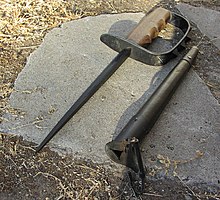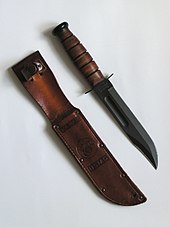Combat knife


Combat knives are knives designed for military use that are used for close combat . While historical models were mainly used as weapons, the focus of modern combat knives is on their use as tools. Trench daggers - as they were used in the trench warfare of the First World War - usually have impact protection for the fingers, since they were also used as brass knuckles.
Combat knife as a weapon
Historical combat knives were designed as a weapon. That is why they usually had a narrow blade, sharpened on both sides. This blade shape is said to penetrate the body with little resistance and cause smooth cuts. It was assumed that a blood vessel that was cut smoothly inside the body would not close itself properly.
With combat knives as a weapon, a distinction is made between cutting weapons and stabbing weapons .
In the case of stabbing weapons, the point is a direct extension of the handle to enable a stab that has just been executed. The hand protection is usually double-sided to prevent the hand from slipping on the blade.
A predominantly designed as Hiebwaffe Kampfmesser is the Khukuri the gurkhas which is curved inwards and has a length of about 30 cm.
Combat knife as a tool
Modern combat knives are designed as sturdy multi-purpose tools as close combat has lost its military importance. They therefore have wider blades that are ground on one side. The blades are usually blackened to avoid light reflections that are visible from afar.
The modern form of the combat knife is also known as a tactical knife , field knife or survival knife . The standard knife of the Bundeswehr - Infantry is the KM 2000 .
The knives are often equipped with additional functions. A serrated edge makes it easier to cut through fibrous material. A saw toothing in the back makes it easier to cut through wood and sheet metal. A glass breaker at the end of the handle is suitable for smashing vehicle windows. A hollow handle is used to store small objects protected from water. Modern bayonets can also often be used as wire cutters by connecting the knife to the sheath.
In order not to damage the cutting edge when splitting wood (so-called batoning ), modern infantry combat knives usually have a thick blade.
literature
- Eugen von Halasz: German combat knife. Volume I, Volume II, Volume III. Wieland publishing house, 2007
- Frank Pelny: Gjogsul: Military close combat in the NVA. ISBN 9783848239061 .
- Wolfgang Peter-Michel: Trench Daggers: Military combat knives of the First World War. ISBN 9783842377196 .
- Thomas Laible: daggers and combat knives. Venatus, 2000, ISBN 9783932848230 .
- Dietmar Pohl, Jim Wagner: Combat knife - knife fight: knife models, carrying systems, fighting techniques. ISBN 9783938711071 .